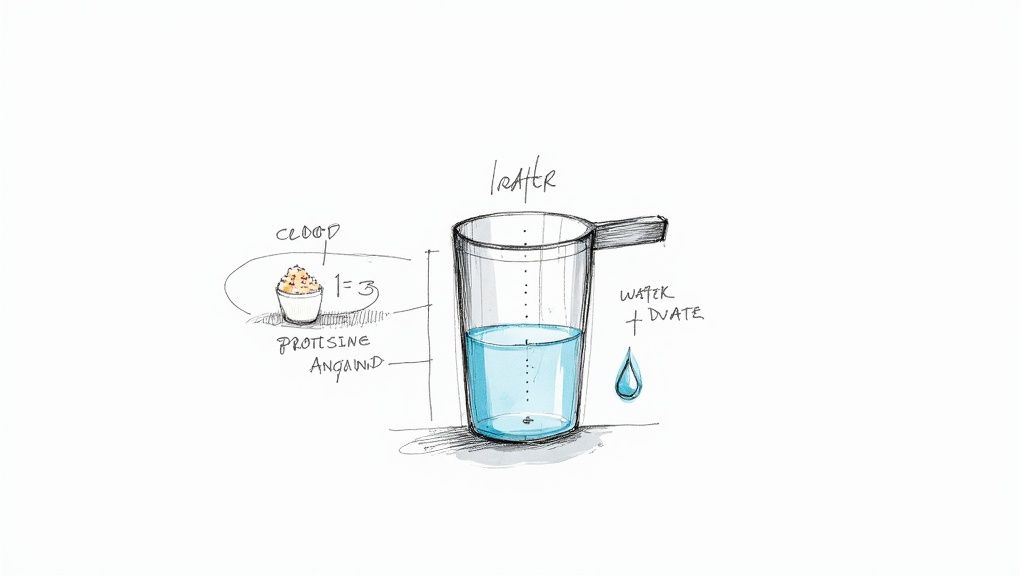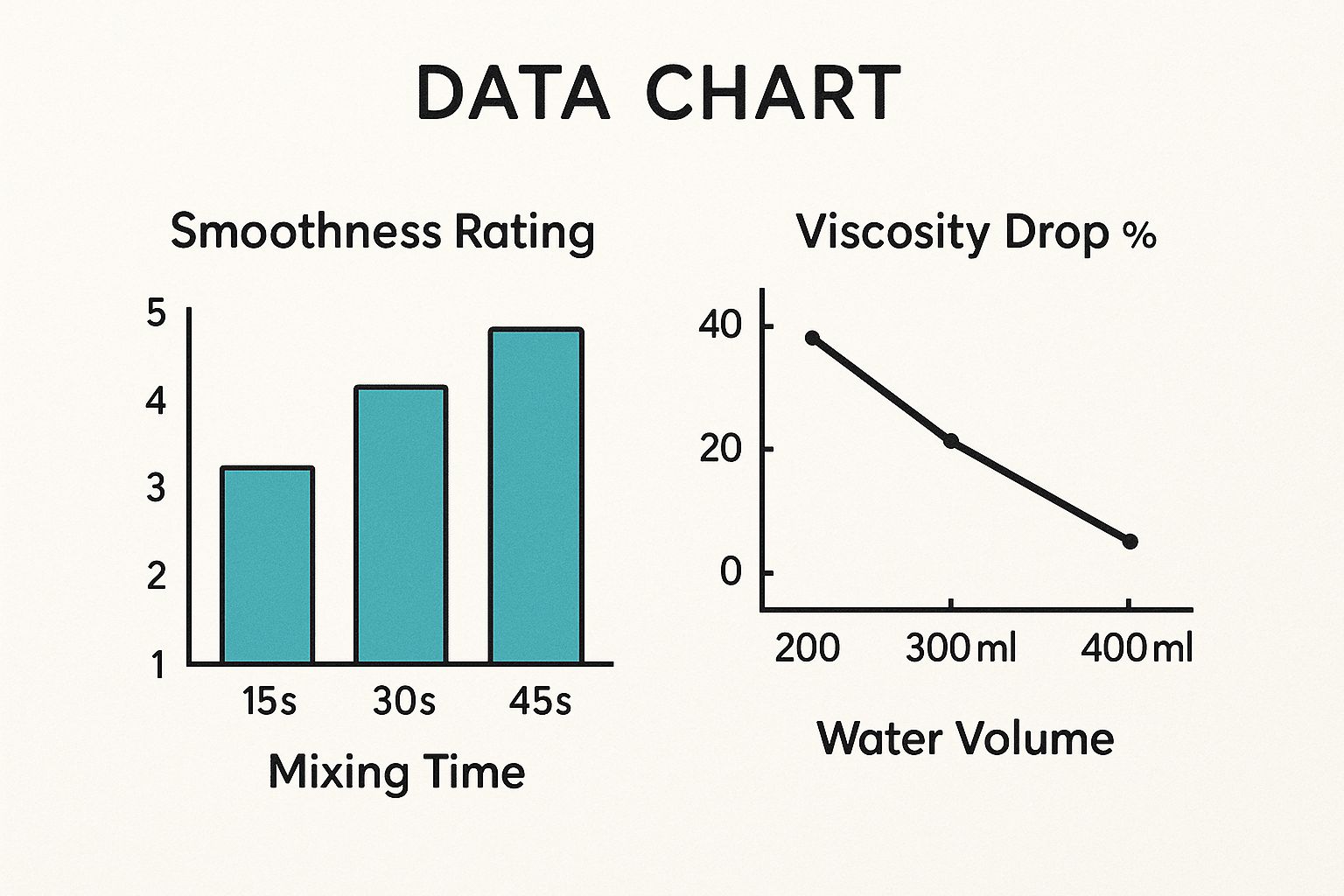Water in Protein Shake: The Easiest Way to Hit Your Goals?
Discover the benefits of using water in your protein shake and learn how to create a tasty, balanced drink every time. Find out more today!
Posted by
So, should you mix your protein powder with water? Honestly, for most people, the answer is a big yes. Water is often the smartest and simplest choice for your shake, giving you a clean, no-fuss way to get your protein in without adding extra calories, sugars, or fats.
Why Water Is Your Protein Shake's Best Friend
Let's dive into the classic debate for anyone who uses protein powder: water or something else? While milk and fun plant-based alternatives definitely have their place, sticking with water brings some clear advantages, especially if you're casually keeping an eye on your nutrition.
Think of it this way: your protein powder has a specific nutritional label. When you mix it with water, you're not changing that at all. You get exactly what's on the tub—the protein, the carbs, and the fats, with nothing else muddying the waters. This makes tracking your intake super simple.
The Beauty of Keeping It Simple
Choosing water as your mixer keeps things clean and straightforward. Here’s why it’s often the best move for your daily routine:
- Zero Extra Calories: Water adds no calories, no fat, and no sugar. This is a huge win if you're mindful of your calorie intake or just want lean protein without any hidden extras.
- Faster Absorption: A water-based shake digests more quickly because there are no fats or other nutrients to slow things down. This is great for that post-workout window when your muscles are ready for a refuel.
- A Solid Hydration Boost: It's a simple two-for-one. You're not just getting your protein in; you're also hydrating your body, which supports everything from recovery to overall wellness.
- Unbeatable Convenience and Cost: Water is literally on tap and doesn't cost a thing. You never have to worry about running out of milk or spending extra on pricey alternatives.
The push for convenience is real. The global market for ready-to-drink (RTD) protein shakes—which are almost always pre-mixed with water—is already valued at USD 1.7 billion and is projected to nearly double by 2034. You can discover more about the growing RTD protein market on market.us.
This simplicity also makes life way easier when you're logging your meals. With an app like munchlog.ai, you can just say, "I had one scoop of protein with water," and you’re done. No need to measure that splash of milk or look up its macros. It’s the most straightforward path to staying on top of your nutrition without the stress.
How to Find Your Perfect Water to Protein Ratio

We’ve all been there. You mix up a protein shake, take that first sip, and… it’s either disappointingly watery or so thick you could stand a spoon up in it. The secret to a perfect shake isn't a complicated formula; it's simply about finding your personal water-to-protein ratio.
A great starting point for most protein powders is one standard scoop mixed with 8 to 12 ounces (about 240-350 ml) of water. Think of this as your baseline. It's the sweet spot most brands recommend because it usually results in a smooth, easy-to-drink consistency without those dreaded clumps.
But here’s the thing: your "perfect" shake is all about your personal taste. And the beauty of using water is how incredibly easy it is to adjust.
Customizing Your Shake Consistency
Finding your ideal mix is just a matter of simple experimentation. Here are a few tips to dial it in:
- For a Thicker, Milkshake-Like Texture: Start with less water. Try using just 6-8 ounces per scoop. This creates a richer, more dessert-like feel that many people find more satisfying.
- For a Thinner, More Hydrating Drink: If you prefer a lighter consistency that’s easy to chug down, simply add more water. Going with 12-16 ounces will give it the feel of a refreshing sports drink.
Keep in mind that different protein powders absorb liquid differently. Plant-based proteins, like pea or soy, often need a bit more water to dissolve smoothly compared to a typical whey protein. So don't be afraid to tweak the amount until you find what works for your specific powder.
Getting the ratio right does more than just improve the taste. A standard serving of about 30 grams of protein powder is typically mixed with 250–350 ml of water, which makes hydration a built-in part of your protein routine and affects everything from nutrient absorption to how full you feel.
Once you nail down your ideal ratio, hitting your daily protein targets becomes something you actually look forward to. And if you’re not quite sure what those targets should be, our guide on how to calculate your daily protein needs can help you figure it out.
Choosing Your Mixer: Water vs. Milk
The liquid you mix your protein powder with does a lot more than just turn it into a drink. It's a game-changer for the final taste, texture, and—most importantly—the nutritional stats of your shake. Water is the simple go-to, but sometimes you just need something a little richer or creamier.
Let’s look at the most common mixers so you can make the right call for your goals and tastebuds. It's not about finding one "perfect" liquid; it’s about understanding what each one brings to the table. Think of it like picking an outfit: what you choose depends on the day's agenda and your mood.
Comparing Your Mixer Options
Deciding between water, dairy milk, or a plant-based option really boils down to what you want to add to your protein. Water gives you a straight-up protein boost with nothing extra. Milk and milk alternatives, on the other hand, contribute their own nutrients, flavors, and, of course, calories.
Here’s a quick look at how the most popular choices stack up.
Protein Shake Mixer Comparison
Let's break down the nutritional impact of common liquids per 8 oz (240ml) serving. This will help you see exactly what you're adding to your protein scoop.
| Liquid | Calories (Approx.) | Protein (Approx.) | Carbs (Approx.) | Best For |
|---|---|---|---|---|
| Water | 0 | 0g | 0g | A quick post-workout refuel, cutting calories, or getting the fastest possible protein absorption. |
| Dairy Milk (2%) | 122 | 8g | 12g | Building muscle, creating a filling snack or meal replacement, or when you crave a classic creamy shake. |
| Almond Milk | 30-40 | 1g | 1g | A low-calorie, creamy alternative that adds more flavor than water without the dairy. |
| Oat Milk | 120 | 3g | 16g | A rich, dairy-free option for maximum creaminess and an extra boost of carbohydrates for energy. |
As the table shows, using water in your protein shake keeps your macros clean and simple—it's pure protein and whatever is in your powder. But if you want a more filling snack, milk is a solid choice. Tracking these differences is easy with tools like munchlog.ai; you can just tell the app, "I had a scoop of protein with oat milk," and it’ll handle the math for you.
The liquid you choose is a powerful tool for customizing your nutrition. Water keeps it lean, while milk adds a sustained-energy component with its mix of protein, fats, and carbs. It’s all about aligning the mixer with what you need in that moment.
This visual guide shows how simple things like shaking time and water volume can totally change your shake's final texture.

It's clear that shaking for at least 30 seconds makes a huge difference in smoothness. You can also see how quickly adding more water thins out the consistency, which is perfect if you don't like a thick, heavy shake.
How to Make Your Water-Based Shake Actually Taste Good
Let's be real: a protein shake mixed with just water can be a little underwhelming. But choosing a zero-calorie mixer doesn’t mean you’re doomed to a bland, watery experience. With a few simple tricks, you can turn that functional shake into something you actually look forward to drinking.
The key is to think of it as building flavor without piling on unwanted calories.
Easy Flavor Enhancers
You can completely change your shake's taste using simple ingredients you probably already have at home. The best part? They're a breeze to log in your food tracker.
- Spices: A dash of cinnamon or a pinch of nutmeg can add a surprising amount of warmth and perceived sweetness for virtually no calories.
- Extracts: A tiny drop of vanilla or almond extract is all it takes to give your shake a rich, dessert-like vibe.
- Powders: For a classic flavor boost, add a spoonful of unsweetened cocoa powder for a deep chocolate taste or a bit of instant espresso powder for a coffee-house kick.
The most effective healthy habits are the ones you can stick with, and it's a lot easier to be consistent when things taste great. Making your shake enjoyable is a simple hack to ensure you hit your protein goals without it feeling like a chore.
Even a handful of frozen berries or a splash of chilled coffee can make a world of difference. For more ideas on using simple ingredients to create flavorful, hydrating drinks, check out our recipe for barley water.
Tracking these small additions is just as easy. Simply tell munchlog.ai, "I had one scoop of vanilla protein with water and a dash of cinnamon," and let the app figure it out. It's all about making your routine both delicious and effortless.
Effortlessly Track Your Shakes with Munchlog AI

You’ve mixed the perfect shake—now what? Keeping tabs on your daily nutrition shouldn’t be a grind, especially when life gets busy. This is where logging your shake, whether it’s made with water or milk, can become incredibly simple.
With a tool like munchlog.ai, you can forget about manually typing in every single ingredient. Instead, you just speak. Imagine finishing your shake and saying, "I had one scoop of whey protein with almond milk and a banana." That's all it takes. The app instantly crunches the numbers, breaking it down into calories, protein, carbs, and fat.
This hands-free approach helps you stay on top of your nutrition without getting bogged down in the details. It’s perfect for getting a clear picture of your diet and making sure you hit your protein targets, minus the stress of old-school tracking.
Voice Logging Made Simple
The real magic is in how easily you can add extra ingredients. Did you toss in a handful of spinach or a spoonful of peanut butter? Just say it. The app is built to understand how people actually talk about food, making it one of the most intuitive tools out there.
For instance, tracking a water in protein shake is as straightforward as it gets:
- Simple Shake: "Log one scoop of chocolate protein with water."
- With Add-ins: "I had a scoop of vanilla protein with water, a handful of spinach, and some frozen berries."
Protein supplements are a huge industry for a reason—we're all looking for convenient ways to support our health. The U.S. market alone was valued at over USD 10.49 billion, showing just how much people care about hitting their goals. Accurate tracking is what makes these products truly effective for you. Discover more insights about the protein supplement market.
This method completely removes the friction that causes so many of us to give up on tracking our food. If you want to see just how easy it can be, check out our guide on finding an easy food tracking app.
Got Questions About Your Protein Shake? We've Got Answers
Still wondering about the best way to mix your protein shake with water? You're definitely not the only one. Let's clear up some of the most common questions so you can shake, drink, and refuel with confidence.
We'll keep it simple and give you the straight-up, practical answers you need.
Does Water Temperature Matter?
It sure does! Cold water is almost always your best bet. Not only is it more refreshing, but it helps most protein powders (especially whey) dissolve smoothly without getting clumpy.
Ever tried mixing protein with hot water? It's generally a bad idea. The heat can cause the protein to "denature," which is just a sciencey way of saying it cooks. Think about what happens to an egg in a hot pan—it solidifies. The same thing can happen to your powder, leaving you with a lumpy, unappetizing mess. For a smooth shake, stick with cold or room-temp water.
Does Water Help You Absorb Protein Faster?
For the most part, yes. Water is a straight shot for your digestive system. It has no fat, fiber, or complex carbs to slow things down, so your body can get right to work absorbing the protein.
This is exactly why a water-based shake is a great choice right after a workout. You’re fast-tracking amino acids directly to your muscles when they need them most for repair. Milk, on the other hand, contains fats and slower-digesting casein, which makes for a more gradual, sustained release of nutrients. Both are useful, but if speed is what you're after, water is the clear winner.
Can You Mix Your Shake Ahead of Time?
You can, but it’s probably not the best idea. For the best taste and consistency, you should always aim to drink your shake right after you mix it—or at least within an hour or two.
Letting a protein shake sit around, even in the fridge, gives the powder time to settle and turn gritty. It just doesn't taste as good. Our advice? Carry your dry powder in your shaker bottle and just add water when you're ready to drink.
The whole point is to make nutrition easy and effective. Keeping it simple by mixing your shake on the spot guarantees a better-tasting drink and helps build a habit you can actually stick with.
It’s a tiny tweak that makes a huge difference.
Is a Water-Based Shake Okay on an Empty Stomach?
Absolutely. Most people have no problem at all drinking a protein shake with water on an empty stomach. In fact, it's a great way to refuel after a morning workout without feeling stuffed.
Because it digests so quickly, it’s an efficient way to get nutrients into your system fast. If you know you have a sensitive stomach, you might try having it with something small like a banana, but for most people, it's totally fine.
Ready to stop guessing and start tracking your nutrition the easy way? With munchlog.ai, you can log your protein shakes and meals just by speaking. Get a clear picture of your macros without the stress of manual entry. Try it today and see how simple staying mindful of your diet can be at https://munchlog.ai.